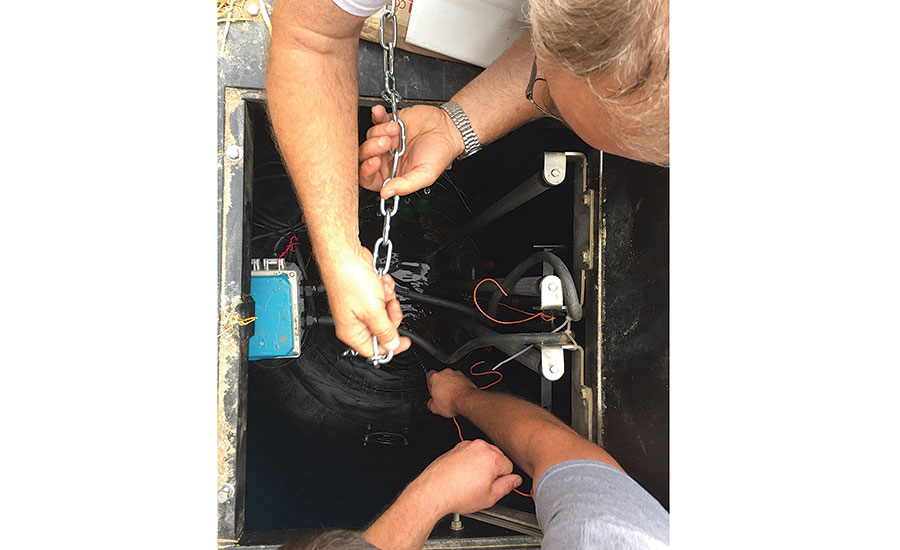As a mechanical contractor, I appreciate bidding jobs when an engineer has provided specifications and will be inspecting the installation for final approval.
For this job at York County (Pennsylvania) Parks’ Nixon Park, the overall job was the installation of a duplex sewage grinder pump basin, connecting to the building’s existing sewer line ahead of the septic tank, and the installation of 2,860 feet of 2-inch HDPE plastic piping that will connect to the township municipal sewer system, which includes a 50-foot rise in elevation. Our bid would include the basin, pumps, and connections to the building’s sewer line and HDPE force-main. After 48-years of experience in PHVAC, this appeared to be a relatively straight-forward project. We were awarded the bid for our portion of the project.
Duplex grinder pump station (Specifications provided by the engineer)
-
Pumps shall be Goulds Model 1GA, Impeller C, 4 HP, 3-phase. Personnel will have to determine the voltage available at the site. Pumps shall be capable of pumping 25 gpm at 88 feet of total dynamic head.
-
Pump discharge is 1 1/2 inches. A 1 1/2-inch by 2-inch increaser will be necessary to transition pipe sizes. Base elbow for fiberglass basin shall be 1 1/2 inches.
-
If the control panel is installed in building, a NEMA 1 panel is acceptable. A quick disconnect switch must be provided at the station location. If control panel is installed outside at the pump station, a NEMA 4X control panel is required and no quick disconnect is required.
-
A 36-inch-diameter fiberglass pump station is acceptable. The depth of the wet well can only be determined by knowing the depth of the influent pipe.
-
Forcemain shall be 2-inch HDPE, SDR 11.
-
Odor control may be required (depending on where the forcemain connection point is located, ie. residential neighborhood).
The superintendent of the York County Parks had, I thought at the time, a very unusual request. He wanted us to install a wye ahead of the new grinder pump station with slice valves so that he could switch between septic and grinder pump systems in the unlikely event our dual grinder pump system failed. Otherwise, they would have to close the Nixon Park building, which hosts thousands of school field trips each year. Thinking, “Well, that’s a waste of money,” I would soon discover his was one of the best suggestions I’ve ever had, and you’ll see why by reading further.
We provided the individual leg voltages for the three-phase 4-HP grinder pumps to our wholesaler, which were:
Terminals 1-2 = 212.8 volts
Terminals 2-3 = 213.5 volts
Terminals 1-3 = 211.1 volts
Terminal 1-ground = 122.7 volts
Terminal 2-ground = 122.8 volts
Terminal 3-ground = 122.5 volts.
The weatherproof outdoor control panel would alternate between pumps for equal runtime. We utilized charts from the NEC (National Electric Code) to determine the correct size for the sheathed copper conductors and ran separate underground 2-inch PVC conduits for line and low voltage, none of which was dictated by the engineer in the specifications. In my area of the country the only trade requiring a license is plumbing. As a result, we are free to provide the electrical side of our installations, but still need to pass the inspection by the authority having jurisdiction to ensure compliance with the NEC. It was eight 12-gauge conductors for the two grinder pumps and eight 14-gauge conductors for the floats and sensor for the 100-foot run from control panel to waterproof junction box in the basin.
Multiple glitches
The first glitch rose its ugly head when we checked the 4-HP 3-phase pump label and realized our supplier had shipped 230-volt models instead of the required 200-volt models we had ordered! This, of course, caused a delay while we waited for the correct voltage pumps.
The second glitch occurred as soon as we installed the correct voltage pumps and activated the system. It turned out the control panel thermal overload protectors were significantly undersized, causing system lock-outs. Once we received the correct thermal overload protectors and began testing the pumps, it was immediately apparent both motors were running backwards, and a quick swap between two of the terminals had both pumps running and pumping into the dry 2,860 feet of 2-inch HDPE like a champ. All’s well that ends well? Not a chance. Pumping into a dry line did not provide the TDH they would need to overcome. Lid was closed, locked and everyone went their merry way.
The third glitch. A distress call from the Parks’ assistant director that the high-level alarm had gone off and that he had activated the diversion from grinder station to septic system by altering the OPEN/CLOSED slice-valves. Turned out to be a brilliant suggestion! Upon arrival, we were faced with a steaming-hot slurry of raw sewage resulting in both grinder pumps running for what we had to assume was several days. They weren’t dead-headed because there is a small-diameter hole drilled in each pump’s discharge pipe (as per instructions), which allowed a discharge and certainly was stirring up the tank’s contents. This drew quite the audience of the individuals involved in the project. The engineer dictated we would have to remove both grinder pumps to have them tested.
The test results
Both pumps are rated for a max of 120 feet of total dynamic head or TDH. The engineer listed the TDH at 88 feet for the Nixon Park, 2,860 feet of 2-inch HDPE pipe and 50-foot change in elevation. The grinder pumps can attain max TDH of 133 feet and 138 feet, indicating there is nothing wrong with either pump.
We also know, from our onsite pressurized flush (using the fire hydrant as the water source) at 70 psi, that the 2-inch HDPE sewer line is not clogged, pinched off or compromised. During the water flushing, the discharge could be plainly heard at the municipal sewer manhole near the park entrance.
Following notification that the pumps were not able to discharge sewage from basin to the municipal sewer, I contacted Xylem tech service and requested assistance determining the TDH. Their response indicated that at 50 gpm, we would be slightly over 190 feet TDH. Please note that they indicated a lower flow rate would also lower TDH but did not provide a chart.
The pumps and basin package are as specified by the engineer. When we met with the engineer onsite, he was adamant that the TDH was only 88 feet. However, at this point we can be certain that the TDH exceeds 138 feet.
Now we were caught between a rock and a hard place with the engineer holding firm that he was correct, with two grinder pumps that were independently tested and confirmed to be performing properly, and a sewage system not working. No surprise that the York County Parks wanted this resolved and the engineer, at this point, removed himself from any responsibility while refusing to do anything more.
Tag – you’re it. A hastily convened meeting was arranged, and all present looked my way to ask if I could get the system operating. “Absolutely,” I replied. We already knew how much water pressure was required from our flow test to move fluid from tank to municipal sewer, so from my point of view, I thought a quick call to the manufacturer would result in one of its engineers selecting the correct grinder pump. Not so fast! The manufacturer dictated all communication had to go through our wholesaler.
Laura Kemp, our sales contact at Northeastern Supply, stepped right up and became the go-between with the manufacturer. All the specifics were provided with only one caveat — I requested they find a grinder pump model that could work with the existing control panel and our underground wiring in order to save the Parks money since the engineer had bowed out, refusing to defray any additional costs. After some back-and-forth exchanges, a 6-HP 3-phase grinder pump selection was the ideal substitute. Aside from new pumps, we only would need to install new relays in the control panel and our wiring was adequately sized to accommodate the higher-amperage load.
We returned to Nixon Park, installed a single 6-HP grinder pump and reactivated the system. The control panel provides the option of isolating either pump to operate as a simplex (single pump) system in case one pump is down and needs to be replaced/repaired. Having been burned once, the Parks did not want to pay for a second grinder pump until it was confirmed the new 6-HP model would be able to handle the TDH. We would be on the hook for the special-order non-returnable grinder pump if it failed to adequately move raw sewage from pit to street! The moment of truth had arrived and, as expected, the system works exactly as anticipated.
It’s been several months since the slice valves were OPENED/CLOSED to revert from septic to sewage grinder station. The York County Parks is happy, our reputation is preserved, and all is truly well that ends well.




